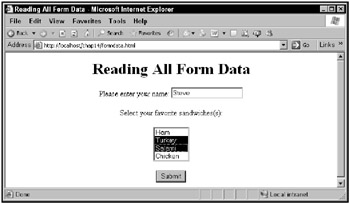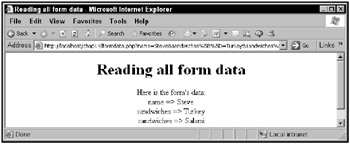Displaying All the Data in a Form
You can use PHP to display all a form’s data. Following is an example, formdata.html, which includes a form containing a text field:
<html> <head> <title>Reading All Form Data</title> </head> <body> <center> <h1>Reading All Form Data</h1> <form method="post" action="formdata.php"> Please enter your name: <input name="name" type="text"> . . . <br> <br> <input type="submit" value="Submit"> </form> </center> </body> </html>
as well as a <select> control:
<html> <head> <title>Reading All Form Data</title> </head> <body> <center> <h1>Reading All Form Data</h1> <form method="post" action="formdata.php"> Please enter your name: <input name="name" type="text"> <br> <br> Select your favorite sandwiches(s): <br> <br> <select name="sandwiches[]" multiple> <option>Ham</option> <option>Turkey</option> <option>Salami</option> <option>Chicken</option> </select> <br> <br> <input type="submit" value="Submit"> </form> </center> </body> </html>
To read all the data in this form, you use a special form of the foreach loop in a new PHP page, formdata.php:
<html> <head> <title> Reading all form data </title> </head> <body> <center> <h1>Reading all form data</h1> Here is the form's data: <br> . . . </center> </body> </html>
You can loop over an array with string indices rather than numeric indices, such as the $_REQUEST array, using a foreach loop like this: foreach($_REQUEST as $index => $value), which places the index in $index and the associated value in $value each time through the loop:
<html> <head> <title> Reading all form data </title> </head> <body> <center> <h1>Reading all form data</h1> Here is the form's data: <br> <? foreach($_REQUEST as $index => $value){ . . . } ?> </center> </body> </html> Note that some values in the $_REQUEST array can be arrays themselves (as with multiple-selection <select> controls), in which case you need another foreach loop:
<html> <head> <title> Reading all form data </title> </head> <body> <center> <h1>Reading all form data</h1> Here is the form's data: <br> <? foreach($_REQUEST as $index => $value){ if(is_array($value)){ foreach($value as $item){ echo $index, " => ", $item, "<br>"; } } . . . } ?> </center> </body> </html> Otherwise, you can just display the current $index/$value pair:
<html> <head> <title> Reading all form data </title> </head> <body> <center> <h1>Reading all form data</h1> Here is the form's data: <br> <? foreach($_REQUEST as $index => $value){ if(is_array($value)){ foreach($value as $item){ echo $index, " => ", $item, "<br>"; } } else { echo $index, " => ", $value, "<br>"; } } ?> </center> </body> </html> Formdata.html, crammed full of data, is illustrated in Figure 14.1.

Figure 14.1: The formdata.html page
When you click the Submit button, all the form’s data appears, as shown in Figure 14.2.

Figure 14.2: The formdata.php application